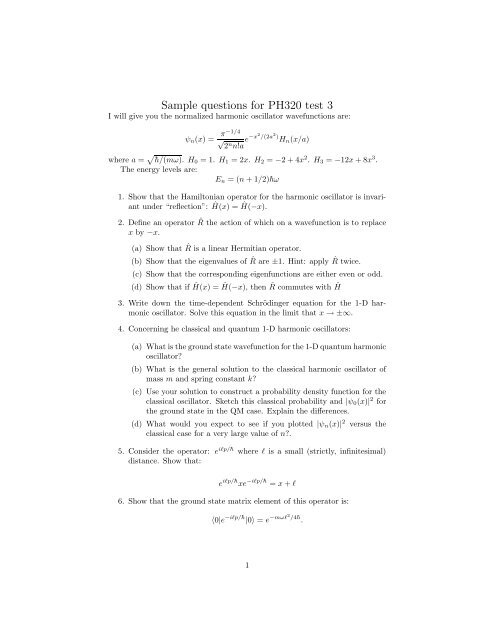Sample questions for PH320 test 3
Sample questions for PH320 test 3
Sample questions for PH320 test 3
Create successful ePaper yourself
Turn your PDF publications into a flip-book with our unique Google optimized e-Paper software.
<strong>Sample</strong> <strong>questions</strong> <strong>for</strong> <strong>PH320</strong> <strong>test</strong> 3<br />
I will give you the normalized harmonic oscillator wavefunctions are:<br />
ψ n (x) =<br />
π−1/4<br />
√<br />
2n n!a e−x2 /(2a 2) H n (x/a)<br />
where a = √¯h/(mω). H 0 = 1. H 1 = 2x. H 2 = −2 + 4x 2 . H 3 = −12x + 8x 3 .<br />
The energy levels are:<br />
E n = (n + 1/2)¯hω<br />
1. Show that the Hamiltonian operator <strong>for</strong> the harmonic oscillator is invariant<br />
under “reflection”: Ĥ(x) = Ĥ(−x).<br />
2. Define an operator ˆR the action of which on a wavefunction is to replace<br />
x by −x.<br />
(a) Show that ˆR is a linear Hermitian operator.<br />
(b) Show that the eigenvalues of ˆR are ±1. Hint: apply ˆR twice.<br />
(c) Show that the corresponding eigenfunctions are either even or odd.<br />
(d) Show that if Ĥ(x) = Ĥ(−x), then ˆR commutes with Ĥ<br />
3. Write down the time-dependent Schrödinger equation <strong>for</strong> the 1-D harmonic<br />
oscillator. Solve this equation in the limit that x → ±∞.<br />
4. Concerning he classical and quantum 1-D harmonic oscillators:<br />
(a) What is the ground state wavefunction <strong>for</strong> the 1-D quantum harmonic<br />
oscillator<br />
(b) What is the general solution to the classical harmonic oscillator of<br />
mass m and spring constant k<br />
(c) Use your solution to construct a probability density function <strong>for</strong> the<br />
classical oscillator. Sketch this classical probability and |ψ 0 (x)| 2 <strong>for</strong><br />
the ground state in the QM case. Explain the differences.<br />
(d) What would you expect to see if you plotted |ψ n (x)| 2 versus the<br />
classical case <strong>for</strong> a very large value of n.<br />
5. Consider the operator: e ilp/¯h where l is a small (strictly, infinitesimal)<br />
distance. Show that:<br />
e ilp/¯h xe −ilp/¯h = x + l<br />
6. Show that the ground state matrix element of this operator is:<br />
〈0|e −ilp/¯h |0〉 = e −mωl2 /4¯h .<br />
1
7. Suppose we represent the kets |1〉 and |2〉 by<br />
( )<br />
1 1<br />
√<br />
2 −1<br />
and<br />
1<br />
√<br />
2<br />
( 1<br />
1<br />
)<br />
respectively. Then what is |1〉〈1| + |2〉〈2|<br />
8. What approximation do we need to make to consider the ammonia molecule<br />
NH 3 a two state system Would this be possible with the harmonic oscillator<br />
9. Sketch the two lowest energy wavefunctions <strong>for</strong> NH 3 assuming we’ve approximated<br />
the potential as a double-square-well.<br />
10. What property of the wavefunctions tells you which has lowest energy<br />
11. We know that any wavefunction ψ(x, 0) can be expanded in the normalized<br />
eigenstates:<br />
∞∑<br />
ψ(x, 0) = B n ψ n (x).<br />
Show that<br />
ψ(x, t) =<br />
n=0<br />
∞∑<br />
C n e −iEnt/¯h ψ n (x)<br />
n=0<br />
where C n and B n are some coefficients to be determined.<br />
12. Consider a harmonic oscillator state:<br />
|ψ〉 =<br />
1 (<br />
√ |1〉 + e iν |2〉 )<br />
1 + λ 2<br />
Find the values of λ and ν <strong>for</strong> which this state is normalized.<br />
13. Prove that [Â, B]∗ = −[A, B] <strong>for</strong> self-adjoint operators.<br />
14. Show that <strong>for</strong> any differentiable function f<br />
[ ˆP , f(ˆx)] = −i¯hf ′ (ˆx)<br />
15. Show that in classical mechanics the equations of a 1-D harmonic oscillator<br />
can be written in the <strong>for</strong>m:<br />
Deduce from this that<br />
d<br />
(p + imωx) = iω(p + imωx).<br />
dt<br />
p(t) + imω(t) = e iωt [p(0) + imωx(0)]<br />
2
16. Show that the eigenvalues of a Hermitian operator are real.<br />
17. Show that the Hermitian conjugate (adjoint) of λ|φ〉〈ψ|† ˆB ∗<br />
is λ ˆB †Â|ψ〉〈φ|.<br />
18. If the Hamiltonian does not depend on time, show that the state of the<br />
system at any time t, denoted by |ψ(t)〉 can be deduced from the state<br />
vector |ψ(t 0 )〉 at some initial time using<br />
where Û(τ) = e−iĤτ/¯h .<br />
|ψ(t)〉 = Û(t − t 0)|ψ(t 0 )〉<br />
19. Show that Û † = Û −1 . This property is called unitarity.<br />
20. Suppose we represent the two-state NH 3 kets |ψ S 〉 and |ψ A 〉 by<br />
( ) 1<br />
0<br />
and (<br />
0<br />
1<br />
)<br />
.<br />
What is the matrix trans<strong>for</strong>mation that tras<strong>for</strong>ms these to the semiclassical<br />
left and right states: |ψ L 〉 and |ψ R 〉 by<br />
3
















